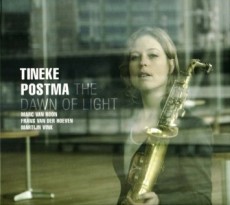
Daily Dose Of Jazz…
Tineke Postma was born in Heereveen, Netherlands on August 31, 1978. At the age of eleven she began playing the saxophone and studied at the Amsterdam Conservatory between 1996 and 2003. She graduated cum laude with a Master’s degree in Music. During this period she also studied under Dave Liebman, Dick Oatts and Chris Potter at the Manhattan School of Music in New York City where she also received a Masters degree.
Postma has performed with Greg Osby, Gerry Allen, Ivan Paduart, Esperanza Spalding, The Metropole Orchestra and has featured and collaborated with Teri Lyne Carrington on the albums For The Rhythm, Journey That Matters and The Mosaic Project in 2011.
Dutch alto and soprano saxophonist Tineke Postma has recorded and released 6 CDs as a leader with her debut coming in 2003 with First Avenue. During 2005 she produced a video Live In Amsterdam: The Teneke Postma Quintet. In between performing, touring, composing she has been teaching at the Amsterdam Academy since 2005.
More Posts: saxophone
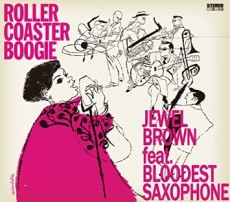
Daily Dose Of Jazz…
Jewel Brown was born on August 30, 1937 in Houston, Texas. Her first professional performance was at the age of 12 in the Manhattan Club in Galveston, Texas. Before graduating from Jack Yates High School, Lionel Hampton offered her the opportunity to tour professionally in Europe.
In 1957 while on vacation in Los Angeles, California she sat in with organist Earl Grant at the Club Pigalle. Grant hired her that night and her performing relationship lasted for a year. Jewel went on to work for Dallas, Texas nightclub owner Jack Ruby. In the next decade she was approached with offers of vocal positions with Duke Ellington and Louis Armstrong. She chose Armstrong and appeared with him in the films Louis Armstrong and All Stars and Solo.
Brown retired from singing and performing in 1971 to care for ailing family members and later established a hair salon in Houston. In recent years she has revived her singing career and in 2012 she released her first album as a co-leader title Milton Jackson & Jewel Brown. The following year she was nominated for a Blues Music Award in the Koko Taylor Award: Traditional Blues Female category. She is currently a member of the Heritage Hall Jazz Band.
More Posts: vocal
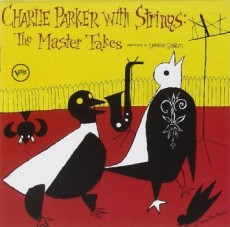
Daily Dose Of Jazz…
Charles Parker, Jr. was born on August 29, 1920 in Kansas City, Kansas but was raised in Kansas City Missouri, the only child of Adelaide and Charles Parker. He began playing the saxophone at age 11 and by age 14 he joined his school’s band using a rented school instrument. His father, a pianist, dancer and singer on the Theater Owners Booking Association (T.O.B.A.) circuit, was often absent but provided some musical influence. His biggest influence at that time was a young trombone player who taught him the basics of improvisation.
By the late 1930s Parker began to practice diligently. During this period he mastered improvisation and developed some of the ideas that led to bebop. He played with local bands in jazz clubs around his hometown perfecting his technique, with the assistance of Buster Smith, whose dynamic transitions to double and triple time influenced the young man’s developing style.
In 1938, he joined pianist Jay McShann’s territory band touring nightclubs and other venues in the Southwest, Chicago and New York City. During this stint with McShann he made his professional recording debut. As a teenager, Charlie developed a morphine addiction while hospitalized after an automobile accident, and subsequently became addicted to heroin.
In 1939 Parker moved to New York City, to pursue a career in music. He held several other jobs as well. He worked for nine dollars a week as a dishwasher at Jimmie’s Chicken Shack, where pianist Art Tatum performed. In 1942 he left McShann and played with Earl Hines for one year alongside Dizzy Gillespie. A strike by the American Federation of Musicians unfortunately resulted in few recordings documenting this period of his playing. He played in after-hours clubs in Harlem with other young cats at the time, such as, Thelonious Monk, Charlie Christian, Mary Lou Williams and Kenny Clarke, creating a music that white bandleaders couldn’t usurp and profit from like they did with swing.
It was while playing Cherokee in a jam session with William “Biddy” Fleet that he hit upon a method for developing his solos that enabled one of his main musical innovations, the 12 semitones of the Chromatic scale could lead melodically to any key, breaking some of the confines of simpler jazz soloing.
By 1945 after the lifting of the recording ban that Charlie’s collaboration with Dizzy Gillespie, Max Roach, Bud Powell and others would have a substantial effect on the jazz world beginning with their June 22, 1945 Town Hall performance. Bebop soon gained wider appeal among musicians and fans alike.
On November 26th of that same year he led a record date for Savoy Records that is arguably the “greatest jazz session ever” with Miles Davis, Curly Russell, and Max Roach. Shortly afterward, the Parker/Gillespie band traveled to an unsuccessful engagement at Billy Berg’s club in Los Angeles. However staying in California he spiraled down into great hardship due to his heroin addiction, ultimately being committed to Camarillo State Mental Hospital for six months.
Although he produced many brilliant recordings during this period, Parker’s addiction led to increasingly erratic behavior. Recording sessions were hard, but he recorded the classic Relaxin’ at Camarillo before his return to New York. He would record a series of sessions with Savoy and Dial record labels, innovate by fusing jazz and classical elements into what would become known as Third Stream, releasing Charlie Parker with Strings.
The influential jazz musician who was at the gate of bebop and the man affectionately known as Yardbird or simply Bird, Charlie Parker died on March 12, 1955, in the suite of his friend and patroness Baroness Pannonica de Koenigswarter at the Stanhope Hotel in New York City while watching The Dorsey Brothers Stage Show on television. The official causes of death were lobar pneumonia and a bleeding ulcer but also an advanced case of cirrhosis and he had suffered a heart attack. The coroner who performed his autopsy mistakenly estimated Parker’s 34-year-old body to be between 50 and 60 years of age. His friend Dizzy Gillespie paid for the funeral arrangements and organized a lying-in-state, a Harlem procession officiated by Congressman and Reverend Adam Clayton Powell Jr., as well as a memorial concert.
He left the world classic jazz compositions, arrangements and versions of tunes such as Ornithology, How High The Moon, Yardbird Suite, Billie’s Bounce, Now’s The Time, Au Privave, Barbados, Relaxin’ at Camarillo, Bloomdido, Blues for Alice, Laird Baird, Si Si, Constellation, Donna Lee, Scrapple From The Apple, Cheryl, Ah-Leu-Cha, Anthropology and Cool Blues among others.
He was posthumously awarded a Grammy for Best Performance by a Soloist in 1974, a Grammy Lifetime Achievement Award in 1984, had two albums Jazz At Massey hall and Charlie Parker with Strings and two singles Ornithology and Billie’s Bounce inducted into the Grammy Hall of Fame. He has been inducted into the Big Band and Jazz Hall of Fame and the Jazz at Lincoln Center: Nesuhi Ertegun Jazz Hall of Fame and had a 32 cent stamp commissioned and issued by the United State Post Office.
More Posts: saxophone
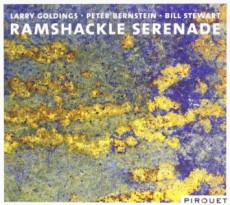
Daily Dose Of Jazz…
Larry Goldings was born August 28, 1968 in Boston, Massachusetts and studied classical piano until the age of twelve. While in high school at Concord Academy his primary influences were Erroll Garner, Oscar Peterson, Dave McKenna, Red Garland and Bill Evans. As a young teenager, Larry studied privately with Ran Blake and Keith Jarrett.
Goldings moved to New York in 1986 to attend a newly formed jazz program under the leadership of Arnie Lawrence at The New School. During college he studied piano with Jaki Byard and Fred Hersch. While still a freshman, Sir Roland Hanna invited him to accompany him to a three-day private jazz party in Copenhagen. While there, he met Sarah Vaughan, Kenny Biurrell, Tommy Flanagan and Hank Jones and had the opportunity to play in the band with Vaughan, Harry Sweets Edison and Al Cohn.
As a college student, Larry embarked on a worldwide tour with Jon Hendricks, working with him for a year. A collaboration lasting almost three years with guitarist Jim Hall followed. By 1988 he began developing his organ chops and secured a regular gig at Augie’s Jazz Bar, now Smoke on Manhattan’s Upper West Side. He was featured with several bands, and his own trio with guitarist Peter Bernstein and drummer Bill Stewart got its start there.
His first release was Intimacy Of The Blues in 1991 followed by sixteen more albums as a leader and has appeared as a sideman on hundreds of recordings. Over the course of his career, Goldings distinctive keyboard sound has been sought out more and more by pop, R&B, Brazilian, and alternative artists, such as, Madeleine Peyroux, John Scofield, Carla Bley, Michael Brecker, De La Soul, India Arie, Tracy Chapman, Pat Metheny, Dave Grusin, Norah Jones, John Mayer, Sia, John Pizzarelli, Steve Gadd, Rickie Lee Jones, Jack DeJohnette, Luciana Souza, and the list goes on and on.
In 2007, Larry, DeJohnnette and Scofield captured a Grammy nomination for Best Jazz Instrumental Album Individual or Group for their live album, Trio Beyond – Saudades. He has been twice awarded Best Organist/Keyboardist of the Year by the Jazz Journalists Association, and twice Best Jazz Album for Awareness and Big Stuff by the New Yorker Magazine.
As a composer his music has been used in the films Space Cowboys, Proof and Funny People. Brecker, Scofield, DeJohnette, Hall, Sia, Toots Thielemans, Curtis Stigers, James Taylor and Jane Monheit among others have recorded his compositions. Organist and keyboardist Larry Goldings continues to perform, record, tour and compose.
Selected discography[edit]
More Posts: organ
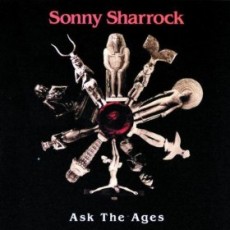
Daily Dose Of Jazz…
Warren Harding “Sonny” Sharrock was born on August 27, 1940 in Ossining, New York. His first love as a child was the saxophone after hearing John Coltrane play on Miles Davis album Kind Of Blue. Unfortunately asthma prevented him from the course so he began playing the guitar. By the time he was a teenager, he started singing in doo-wop groups.
By the late 60s he was collaborating with Pharoah Sanders and Alexander Solla during the first wave of free jazz. He made his recording debut on the 1966 Sanders album Tauhid. Sharrock performed with flautist Herbie Mann, made an un-credited guest appearance on Miles Davis’s project A Tribute To Jack Johnson and the Complete Jack Johnson Sessions, arguably his most famous cameo. He recorded three albums as a leader in the late 1960s through the mid-1970s: Black Woman, Monkey-Pockie-Boo, and an album his wife Linda titled Paradise.
Sonny semi-retired for much of the 1970s, got divorced, got divorced, and worked as a chauffeur and caretaker for mentally challenged children. He returned at the urging Bill Laswell in 1981 and recorded Laswell’s project Memory Serves. He went on to work on the punk/jazz session with the band Last Exit, and during the late 1980s, he recorded and performed extensively with the New York-based improvising band Machine Gun, as well as leading his own bands.
Sharrock flourished with Laswell’s help, performing together, as well as producing his albums such as his solo project Guitar, the metal-influenced Seize the Rainbow, and the well-received Ask the Ages where he featured Pharoah Sanders and Elvin Jones. He would go on to compose the soundtrack for the Cartoon Network program Space Ghost Coast To Coast, recording a total of twelve albums as a leader and six with Last Exit. He would perform and record as a sideman with Ginger Baker, Don Cherry, Pheeroah akLaff, Roy Ayers, Brute Force, and Wayne Shorter among others.
On May 26, 1994 guitarist Sonny Sharrock died unexpectedly of a heart attack in his hometown of Ossining, just as he was on the verge of signing the first major label deal in his entire career. He was 53.
More Posts: guitar


